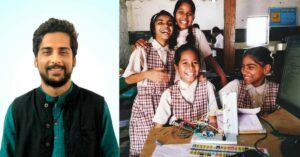E-Inclusion Done Right! This Project In Maharashtra Is Closing The Gaps In Digital India
This project in Maharashtra is helping to close the gaps in Digital India by not only providing lost-cost and easy-access technology to villagers but educating them on how and why they should use it too.

This project in Maharashtra is helping to close the gaps in Digital India by not only providing lost-cost and easy-access technology to villagers but educating them on how and why they should use it too.
As the world moves increasingly ‘online’ many of its poorest people are getting left behind. In India specifically, an economy that continues to grow from strength to strength and rapid developments in technology are contributing to driving the divide between the country’s richest and poorest people to alarming rates. Poor access to technology and low literacy rates are just two examples of factors that are preventing India’s poorest people from advancing beyond their current conditions.

Internet and technology can change the lives of marginalised people, that’s undeniable, but the reality is that many people are technologically illiterate and have no idea how to use a computer. Furthermore, it cannot be assumed that people even want to use technology and many are unaware of the advantages that technology can offer its user. There’s no point then in installing the internet/providing free Wi-Fi/increasing access to technology if people are unaware of how to use it. People need to be educated, not just on how to use the technology available to them but they also need to be told and shown how it can improve their lives and make their daily activities that little bit easier.
Take the example of the Sangram Kendras in Maharastra. Under its e-Panchayat Project, the state government set up designated CSCs (Common Service Centres) across Maharashtra where they provided desktop computers, printers, scanners and internet connection primarily for the use of the residents of local villages. The centres had government office operating hours so were shut in the evenings and on the weekends, making it very difficult for villagers, who adopt the same working hours, to actually make use of the services.
Not only that, the computers have low internet speeds, are limited to downloading 19 government certificates, do not cover facilities like scholarships or online bill payment and only a Sangram Kendra operator has access to the websites where marriages, births or deaths can be registered. It also costs villagers time and money to travel to the centres. Although the initiative has good intentions it doesn’t consider the practicalities and is largely unsuccessful in understanding the needs of the people it tries to help.
Any new project or initiative requires sufficient planning. The needs of its target group must be established and thoroughly understood from the outset or the project risks being unsuccessful and a waste of vital resources.
You may also like: 5 Brilliant Ways in Which NRIs Are Helping People in Rural India with Just a Few Phone Calls!
In April 2014, Partners for Urban Knowledge, Action & Research (PUKAR) and Indian Institute of Technology, Bombay (IIT-B) collaborated in the Research to Internet Access project in three villages in Palghar district: Dhuktan, Khamloli and Bahadoli. The collaboration was part of an experiment by IIT-B to take affordable broadband to a large rural population.
Initially, the equipment the project intended to use in the villages was tested only on the campus of IIT-B beforehand. When they went to set up the same equipment in the villages they found that its many surrounding hills and forests were obstructing the signals, which caused significant delays to the project. The team decided to optimise this time, however, to gaining a better understanding of the needs of the villagers. They conducted a survey covering 1,146 households, which covered important issues such as the degree of affordability, accessibility and awareness about the internet.
The survey provided them with critical information such as the fact that infrastructure and services barely existed, most villagers worked in agriculture and some others were having to commute extremely long distances for work in nearby cities. The information gathered formed the basis of their projects design.
PUKAR spent the next few months creating modules on various government schemes and programmes, based on the villagers’ needs and interests gathered from the survey, that could be accessed via the internet. It also employed and trained 62 young people, ‘e-sevaks,’ to help deliver these services in the villages and also set up meetings with the village authorities where they discussed not only the purpose of the project but also the benefits that it would bring them.
You may also like: 15 Progressive Indian Villages That Will Make You Want to Ditch Your City Life Right Away!
The project saw the setting up of e-kiosks, equipped with laptops, dongles, printers, scanners and projectors. They created a village fund, where users paid small sums for every use, ₹1 to pay an electricity bill; ₹1 to print a document, which was deposited into a special village bank account that they planned to use for activities in the village.
The services of the e-sevaks included home delivery whereby they would travel on two-wheelers with their equipment, from village to village and door to door, spreading awareness among the villagers about how they could use the internet to assist with their daily activities. The e-sevaks would also download forms for the villagers, scan documents, print them out and create e-lockers for them.
Since February of this year the project has been working with Vakrangi Kendra, mini-Bank of Maharashtra branches, to add banking to their list of services.
PUKAR hopes to work with the state government to expand the project to all villages in Maharashtra, reaching out to thousands more who could benefit massively.
The project is a good example of what is needed in order to help narrow the gaps in Digital India and ensure that no-one gets left behind.
Like this story? Or have something to share? Write to us: [email protected], or connect with us on Facebook and Twitter.
NEW: Click here to get positive news on WhatsApp!
This story made me
- 97
- 121
- 89
- 167
Tell Us More
We bring stories straight from the heart of India, to inspire millions and create a wave of impact. Our positive movement is growing bigger everyday, and we would love for you to join it.
Please contribute whatever you can, every little penny helps our team in bringing you more stories that support dreams and spread hope.



















